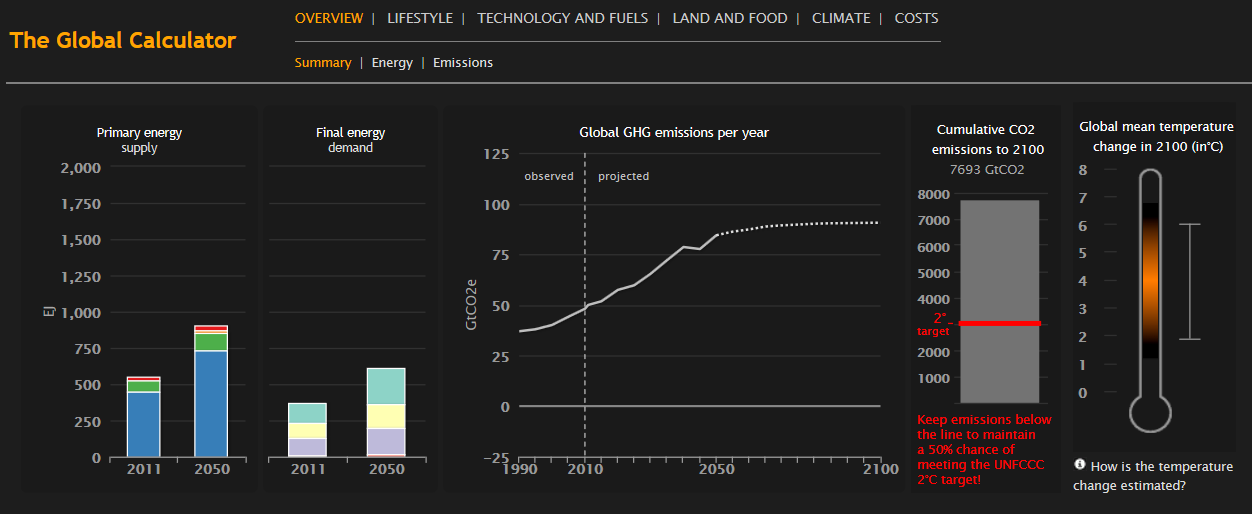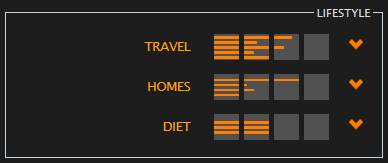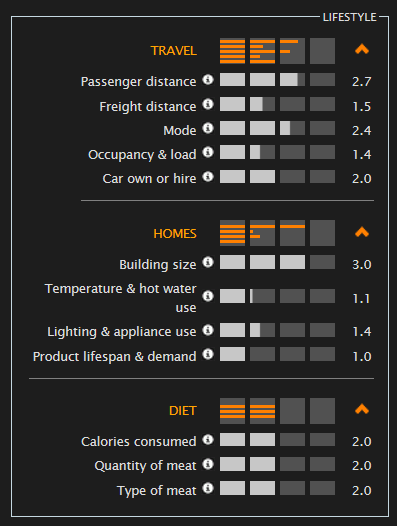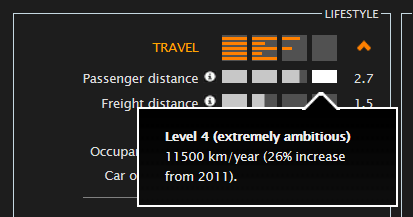Explore different visions of the future from the Calculator team, other models and other organisations.
This page gives you a quick overview of the main functionality of the Global Calculator tool. You can also watch our "how to" video.
When you first open the tool you are presented with a "business as usual" version of the future, which would have a temperature increase of around 6°C by 2100 (the IEA's 6DS approx. scenario).
In the top half of the screen there are a number of outputs that you can explore. This is the overview tab, which gives you the headline information about the current pathway:
- primary energy supply and final energy demand in 2011 and 2050
- global greenhouse gas emissions per year graph
- cumulative CO2 emissions by 2100, with a line indicating the "budget" for having a 50% chance of limiting the global mean temperature rise to 2°C
- a thermometer showing the change in global mean temperature associated with the pathway by 2100.
There are other tabs at the top of the screen that you can explore, which give more detailed information on things like lifestyle, technology and fuels, and climate.

As well as this business as usual pathway, you can explore a number of other pre-loaded example pathways using the drop-down menu in the middle of the screen. Or you can design your own pathway using the levers.
Controlling the Calculator
You control the Calculator using around 40 levers that represent changes that would mitigate against climate change from now until 2050. These appear on the bottom half of the screen. For each lever you can choose different levels of effort – for most this will range from level 1 (make minimal effort to tackle climate change), to level 4 (make an extraordinarily ambitious and extreme level of abatement effort). For example you can choose to build nuclear power stations, reduce the distance people travel by car, or change people's diets. Each level is represented by a boxes to the right of the lever name. Click on a box to select that level.
When you first see the calculator, it can be a bit overwhelming - don't be afraid to start clicking on the levers to see the impact the changes make on emissions and the climate. You can always go back and change anything later as your understanding improves.
The levers are split into four cateogries:
- lifestyle (left section),
- technology and fuels (middle section)
- land and food (right section)
- demographics and long terms (right section).
When you first open the Calculator there are only 15 grouped levers visible, which are coloured orange. By clicking on these grouped levers you can get a sense of the overall abatement potential of different sectors, like manufacturing or land use.

You can expand the levers by clicking on the down arrow next to each of their names to see the 40 main levers, coloured white. These give you more control on what happens within sectors - for example you can choose to not deploy electric vehicles, but to make non-electric vehicles more efficient.

If you hover over the level box, you can see a summary description of what the levels mean. For more information about the lever, click on the lever name (e.g. “passenger distance”) and you will open up a full description giving background information, graphs and more detail about this lever.

The level you have selected is indicated by white shading. You do not just have to choose between the whole numbers 1, 2, 3 and 4, but can select levels between. To do this, click on the square multiple times, and you will step down 0.1 each time. For example, to set a lever to level 1.8, click on the level 2 square three times to step down from 2, then to 1.9 and then 1.8.
You can choose any combination of lever choices to create your own unique "pathway", and then explore the implications.